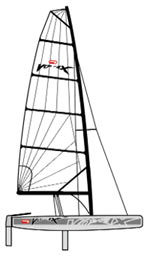Laser Vortex
One design
This shape was prototyped successfully with the Moth class in the '60s and '70s, but proved so dominant the class rules were changed to prevent the tunnel from running the full length of the hull. This reduced the effectiveness of the tunnel so that it disappeared from the class. As a one-design, however, the Vortex has no such restraints, and there is light at the end of this tunnel with about one square foot of "light" above the flotation plane.
Despite the similarities, there is a complete difference between the Vortex and a catamaran in that the tunnel hull of the Vortex performs like one continuous hydrodynamic surface whereas a cat has two independent hydrodynamic surfaces. This means the interaction of water between the tunnelled hulls enhances performance while the interaction between the hulls of a cat tends to diminish the performance. As the water enters the tunnel it is forced down the tapered surface producing lift. This reduces the drag on the hull and reduces pitching while sailing in waves. The Vortex has one rudder and according to the brochure, "incredible tacking speed."
The Vortex also has two daggerboards that are raked forward and canted inward. As a result, the windward board will be near vertical when the boat is heeled and the leeward board will act like a lifting foil to further reduce drag.
Interestingly, if you superimpose the plan view of the Vortex over the plan view of a Laser dinghy you will find the Vortex is only marginally beamier and near identical in LOA. There are, however, two bows instead of one bow, and the stern is broader, which makes for a more stable boat than the Laser.
The brochure goes on to say that the shape of the Vortex allows the sailor to get farther outboard on the trapeze due to the hull shape. Well, come on. If beam is near identical how can you get farther outboard? If, on the other hand, you look at the Vector with its pronounced wings and 6-foot beam it's obvious that this winged configuration allows the sailor to get farther outboard. (The beam of the Vector is about a foot greater than the beam of the Vortex.)
Now, having said that you do have to take into consideration the fact that once heeled the Vortex will ride on its leeward hull, and this will push the transverse center of buoyancy to leeward, which will in turn make the righting moment of the sailor on the wire greater. Keep in mind that for the tunnel hull to work optimally you will need to keep both hulls in the water. But then again, with the windward hull lifted clear, it appears the Vortex would behave like a cat. And that's not so bad either if you are looking for speed.
I do think the stability characteristic of this design will be far more forgiving than those of the Vector type. Your Vortex will not tip over at the dock. Kept level this will be a very stable platform.
The Vortex is strange looking. The bows appear to be squared off in the photos. I estimate the "flat" to be about 1.5 inches across. The inner tunnel surface is entirely fair and contiguous. The deck is gently dished, and there is no cockpit per se. The sheer is generously radiused for comfort on the wire. I imagine changing tacks on the Vortex would be a lot easier than it would on the Vector as you pass through that zone of level stability.
The Vortex is gaining in popularity in the United Kingdom. Experienced sailors are quoted in the brochure as saying this is a wonder, an exciting boat. I think, based upon the stability aspect afforded by the tunnel-hull configuration, I would feel more comfortable in this boat than I would in the Vector. I hope I get the chance to sail a Vortex and see for myself.

Comments